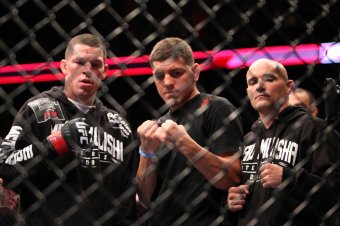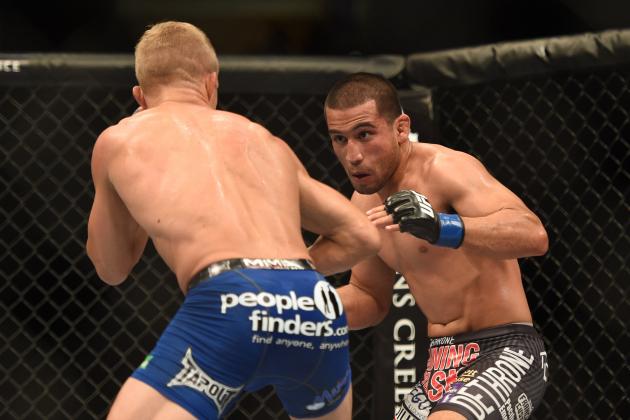The UFC owes more than just a tip of the cap to men like Joe Soto, who more often than not, step up to the plate when another scheduled fight card begins to self-destruct.
Without Soto, UFC 177 would have been the next instance of a fight card gone up in flames. T.J. Dillashaw was left opponent-less after former bantamweight champion Renan Barao fainted just before weigh-ins. Soto fought in the main event after being originally slated for the first fight of the night. The 27-year-old lost, in what was a competitive fight, and received crumbs compared to the champion.
Soto received a modest $20,000 for filling in to fight Dillashaw. To most people, that is a check worth signing. But Soto, who originally was training for a three-round fight with Anthony Birchak, had to alter his game plan towards a completely different fighter.
The California native hadn’t fought in the UFC before, let alone headline an event in his opponent’s backyard. Soto never went into championship rounds, and still managed to take the center of the octagon in Sacramento despite that. He could have turned down such an opportunity against a former training partner, but he decided to be the UFC’s knight in shining armor, and his stock rose because of it.
While we may never know if UFC President Dana White gave Soto a discretionary bonus, he did garner support from fellow fighters.
Awesome fight @TJDillashaw! @ufc @danawhite should give @JoeSoto135 a FAT check. Change that man's life. Great job Joe!
— Daniel Cormier (@dc_mma) August 31, 2014
In a similar situation, current middleweight champion Chris Weidman accepted a fight with Demian Maia on just 11-days’ notice back in January 2012. Weidman was forced to cut 32 pounds in 10 days but it paid off, literally, as he outworked Maia for a hard-fought unanimous decision. Long Island’s own was given $22,000 to show, plus an additional $22,000 for the victory, according to mma-manifesto.com.
Furthermore, light heavyweight Patrick Cummins took a fight on short notice with All-American wrestler Daniel Cormier in February this year. Cummins was paid only $8,000 after a first-round drubbing at the hands of Cormier, who pocketed $160,000 for the knockout.
Somebody needs to advocate on behalf of the little guy. Soto and Weidman, who both went from undercard fighters to televised competitors, deserve more for their troubles. In 2013, 70 percent of post-fight bonuses were awarded to fighters in the main or co-main events. Soto didn’t receive a bonus for giving Dillashaw everything he could handle for nearly 25 minutes. Neither did Weidman, who brought the former middleweight contender to a halt.
Granted, if Soto was to put together a winning streak, he would improve his chances of having his salary raised and also get a win bonus. In the meantime, he is shackled to the undercard, where visibility is limited and sponsorship money is hard to come by. Most of the time, the money one makes from sponsors, is more than he or she would make in base salary.
Just as a company would when plugging a commercial, an MMA brand like Training Mask strategically places their advertisements on fighter trunks. Training Mask was featured on the crotch of Soto’s trunks in his title fight with Dillashaw.

"Sometimes guys come to us because their sponsors got kicked out of the UFC or because they took a fight last minute and don't have any other sponsors," Training Mask CEO Casey Danford told Ben Fowlkes in 2011. “On the last-minute deals, it's not like we're giving them top dollar, because they're coming to us at the last minute.”
With the majority of bonus money going to the men and women on the main card, who are already paid more handsomely than their preliminary brethren, cries for a more sufficient and balanced system of payment have never been louder.
Fighter salary has always been a controversial topic. Martyrs like the Diaz brothers, Rampage Jackson and Jon Fitch have been campaigning for more sufficient pay in recent years. Both Diaz brothers successfully barred themselves from competing before receiving lucrative bouts. Jackson, who was never on good terms with White, claims that the UFC taxes sponsors.
Fitch had an unceremonious divorce from the UFC, which saw White and the former welterweight contender spew venom at each other concerning, among other matters, money. The UFC is worth north of $1 billion so how can a fighter, grinding at the start of a fight card, still see $8,000 in pay? Give me a break. Even pound-for-pound champions have voiced their displeasure with the UFC’s pay scale.
Complaints continued to mount when Nova Uniao teammates, Jose Aldo and Renan Barao, both spoke earlier this year about their salary. According to Aldo, lower weight classes are neglected and are given the same salary as “a beginner.” Both the Brazilian and, even more recently, flyweight contender Ian McCall have said that they aren’t as marketable or are compensated as fairly as their heavier peers.
For all intents and purposes, let’s take a look at the lighter weight classes more closely. In 2014, thus far, 38 events have been held. Of those 38, nine had 145-pound or lower main event bouts. Aldo and Barao each fought in two title fights this year, making a grand total of $530,000 and $96,000 respectively. Both teammates possessed winning streaks dating back years, and their title reigns only started a year apart from each other, so why such a discrepancy in salary?

It’s hard to see why someone like Aldo would complain about salary when he’s hanging just south of Anderson Silva and Jon Jones territory.
Demetrious “Mighty Mouse” Johnson rules the 125-pound kingdom but, according to McCall, has the personality of a “coffee mug.” Despite his less-than-stellar marketability, Johnson earned $362,000 in two flyweight title defenses. Contrary to his nemesis McCall, Johnson is paid quite sufficiently. Back in June, at UFC 174, he made more money than welterweight contenders Rory MacDonald and Tyron Woodley combined.
With fighters big and small coming out of the woodwork, White is going to have to quell the uprising. He seemed to be on the verge of an idea that would level the playing field for all fighters—big and small, weight class to weight class, champion or non-champion—in June 2013. In order to support the fighters on the undercard, who fight paycheck to paycheck, White proposed eliminating all forms of post-fight bonuses to help redistribute the wealth. How about a little democracy, from the UFC President?
However, that proposed idea dissolved real fast when, according to White, he received “A lot of feedback from the fighters, and fighters want the finish bonuses and discretionary bonuses to stay the same.”
It’s on a fighter to do what he or she can to improve their stock and elevate their name. They can either use their hands, elbows or feet. Some prefer to take the road less traveled by using the microphone. But the most reliable way appears to be fighting, and fighting often. Some fighters are adept at both fighting and winning, like Donald Cerrone.
Cerrone has fought eight times over the last two years, collecting four post-fight bonuses, while achieving a 6-2 record. The Cowboy’s in-your-face, scrappy style of fighting is a big draw for White’s pockets. Over his last three fights, Cerrone’s salary—say that five times fast—has fluctuated around the $150,000 range.
The UFC is just like any other professional sport organization, meaning when you’re on the winning track, you’re their golden child; Conor McGregor anyone? Or let’s say you were a once highly coveted fighter, like Jake Shields, who is on the wrong side of 30 and whose production has declined. White can cut a check just as fast as he can send you packing.
It’s White’s way or the highway. It’s his choice to tax sponsors and it’s Joe Silva’s choice on where fighters fight. Exciting fighters, like McGregor and Cerrone, may get more backing and preferential treatment but that’s because they understand the game that’s being played. They fight their tails off and provide the fans in attendance with highlight-reel wins.
Fighting on a UFC undercard can resemble being stuck in purgatory. Each fighter controls their own fate when they step in the octagon. They’ve mobilized a collective voice outside of it but that hasn't worked. Each fighter had a choice of fighting with incentives over a better base salary; they chose the former. All that’s left to do is win.
All salary figures are courtesy of mma-manifesto, mmafighting and cagepotato.




















